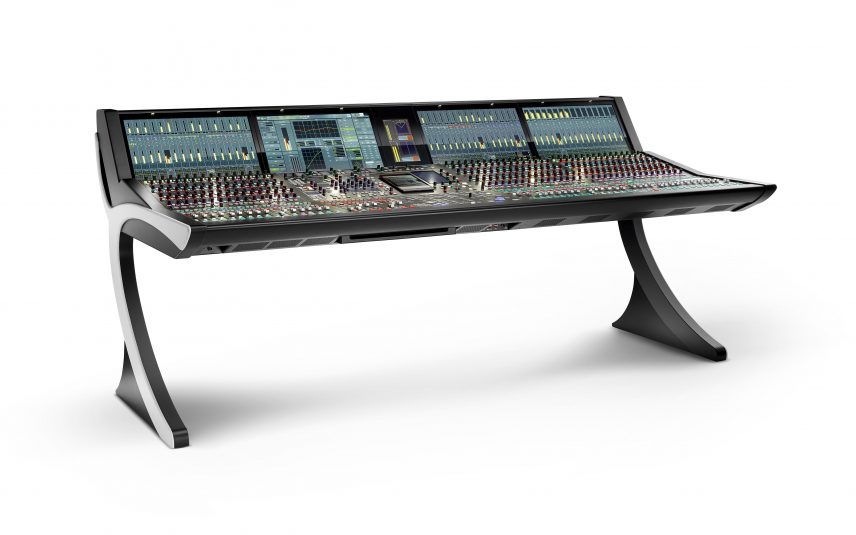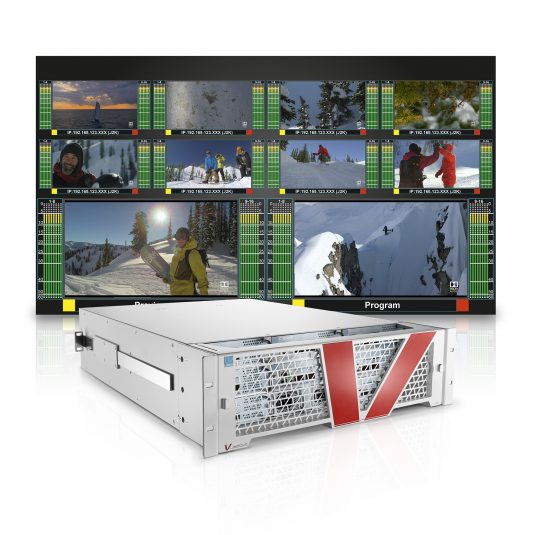NAB 2017: Lawo Highlights IP Capabilities With New Production Console, SOUL Service
IP is a focus at the Lawo booth (N1424), notably in the IP-based mc296 Grand Production Console and Lawo’s Seamless Orchestration and Unification Layer (SOUL), an overarching orchestration service for IP-based production environments. Also on exhibit are the new V__matrix vm_mv24-4 and vm_mv16-4 virtual modules (VMs), which add high-quality multiviewer functionality to the V__matrix ecosystem when loaded onto a c100 core processing module.
MC296 Grand Production Center
The new flagship mc296 audio-mixing console is specifically designed to provide optimal performance in IP video production through native support for all relevant standards: SMPTE 2110, AES67, RAVENNA, and Dante.
Available in frame sizes with 24 to 200 faders with the same legendary quality of Lawo’s mc290 series, mc296 is designed as Lawo’s most visual broadcast console. It features 21.5-in. Full HD touchscreens as well as multiple mini color-TFTs in channel strips and touch-sensitive color-coded encoders, providing fast overview and user-friendly operation.
In a world’s first, Lawo’s new production console features LiveView video thumbnails. In addition to standard channel labeling via channel numbers, individual text labels, and static pictures or icons, the mc296 can display real-time video thumbnails at the fader’s mini TFTs for intuitive channel identification. Touching a fader changes the LiveView thumbnail to full-screen mode, providing a more detailed view of that channel’s video source, such as a camera or a replay machine.
Designed for networking in complex IP production infrastructures, the Lawo mc296 deploys Lawo’s IP-Share Network Gain Compensation when using shared DALLIS I/Os to prevent unexpected changes on up to eight networked consoles when individual users adjust their gain settings. The DALLIS I/O communicates with all networked consoles, and its IP-Share algorithm sets the optimum analog gain for multi-client requirements. IP-Share also ensures that the corresponding gain compensation is applied to the digital gain stages of all consoles when the analog gain of the preamp is being adjusted.
Reflecting today’s requirements for 3D/immersive audio productions, the mc296 provides not only superb tools for surround-sound mixing but also a dedicated elevation controller as standard. Furthermore, the mc296 offers Lawo-grade integrated Loudness Metering with full loudness control in accordance with ITU 1770 (EBU/R128 or ATSC/A85). In addition to program buses, Lawo Loudness Metering can also measure individual channels, which allows fast and convenient “visual” mixing of multiple-microphone setups.
Lawo’s new flagship can also be operated in Multi-User Mode, with 96 rotary encoders in each 16-fader bay giving direct access to all parameters, effectively creating an additional central-control panel.
For ultimate flexibility in I/O requirements, the console offers plug-and-play interfacing to all Lawo DALLIS modular stageboxes including AoIP options and the Lawo A__line interfaces and NOVA central routers. In addition, as the mc?96 surface includes local I/Os that feature comprehensive connectivity with 16 Lawo-grade Mic/Line inputs, 16 Line outputs, 8 AES3 inputs and outputs, 8 GPIOs plus a local MADI port (SFP). A built-in switch provides four Ethernet ports with network connectivity via two redundant SMPTE2110/AES67/RAVENNA ports with seamless protection switching.
Lawo’s SOUL
Making its NAB Show debut, SOUL manages the generation and routing of audio and video streams in any multi-vendor IP setup and is compatible across individual interfaces and technical solutions.
SOUL provides a single point of control for any network size and any network topology and offers the central service for stream routing and resource management across single-switch, spine-leaf, or mesh network infrastructures. Using Ember+, it presents a unified northbound matrix representation of the network toward an overall control system, such as VSM (Virtual Studio Manager), and orchestrates and controls IP-based environments on various levels. SOUL is capable of hitless merge and routing-state recovery and provides sophisticated system redundancy.
Through standardized or vendor-specific APIs, SOUL accesses switches and network components, including encoding and decoding devices, cameras, multiviewers, processors, switchers, consoles, etc., to directly control the generation, registration, and routing of streams. It follows industry specifications like NMOS to utilize devices. In addition, proprietary interfaces are used to achieve a more sophisticated control over edge devices.
SOUL’s key features:
- Ember+ northbound abstraction of the network.
- Switch-API support southbound, with access to multicast routing.
- Full Layer 3 compatibility.
- Agnostic to various switching mechanisms.
- Supported switching modes: Patching, Destination (make-before-break, break-before-make, etc.) and Source Timed Switching (hardware dependent).
- Compatible with NMOS 1.0 (and higher), SMPTE 2022-6, 2022-7, 2110, AES67, RAVENNA.
- Intuitive configuration GUI for fast configuration, template support, browser-based setup.
- Perfect integration with Lawo V__ units.
Multiviewer Modules for V__Matrix
Capable of handling both IP and SDI sources, the V__matrix vm_mv24-4 and vm_mv16-4 virtual modules can monitor uncompressed 4K UHD, 3G, HD, and SD video as well as both embedded and discrete audio while generating pixel-perfect mosaics with ultra-low latency.
The award-winning V__matrix, premiered at NAB 2016, is a software-defined IP core routing and processing platform based on data-center principles of flexibility, fabric computing, and COTS economics. Designed to provide a completely virtualized real-time production infrastructure, V__matrix leverages multiple cores connected to a high-capacity COTS IP network with redundant 10GE and 40GE connections to form a distributed IP routing and processing matrix with frame-accurate, clean switching just like a legacy baseband matrix.
The vm_mv24-4 can monitor up to 24 sources or max 36 Gbps of IP or SDI video; the vm_mv16-4 is capable of up to 16 sources or a max of 36 Gbps. Both multiviewer VMs can generate up to four output heads (mosaics) and scale and display any source on any output head without limitation. The same source can be displayed on multiple output heads at different resolutions. The output heads can be configured as HD, 3G, or 4K and output over IP interfaces or, using the modular rear-plate I/O, as SDI.
Both VMs also optionally support SMPTE2042 VC-2 compressed video, which further increases their monitoring capabilities by allowing monitoring of more 3G and 4K/UHD signals without hitting their respective processing capacity maximums. The VC-2 option also includes the ability to compress the IP output heads, which allows 4K UHD mosaics to be transported over a 10-Gbps IP network.
The V__matrix multiviewer VMs were designed to be controlled by Lawo’s groundbreaking touch-operated configuration system theWALL. This HTML5-based GUI makes mosaic configuration with borders, colors, UMDs, tally, etc., a simple case of drag-and-drop.


